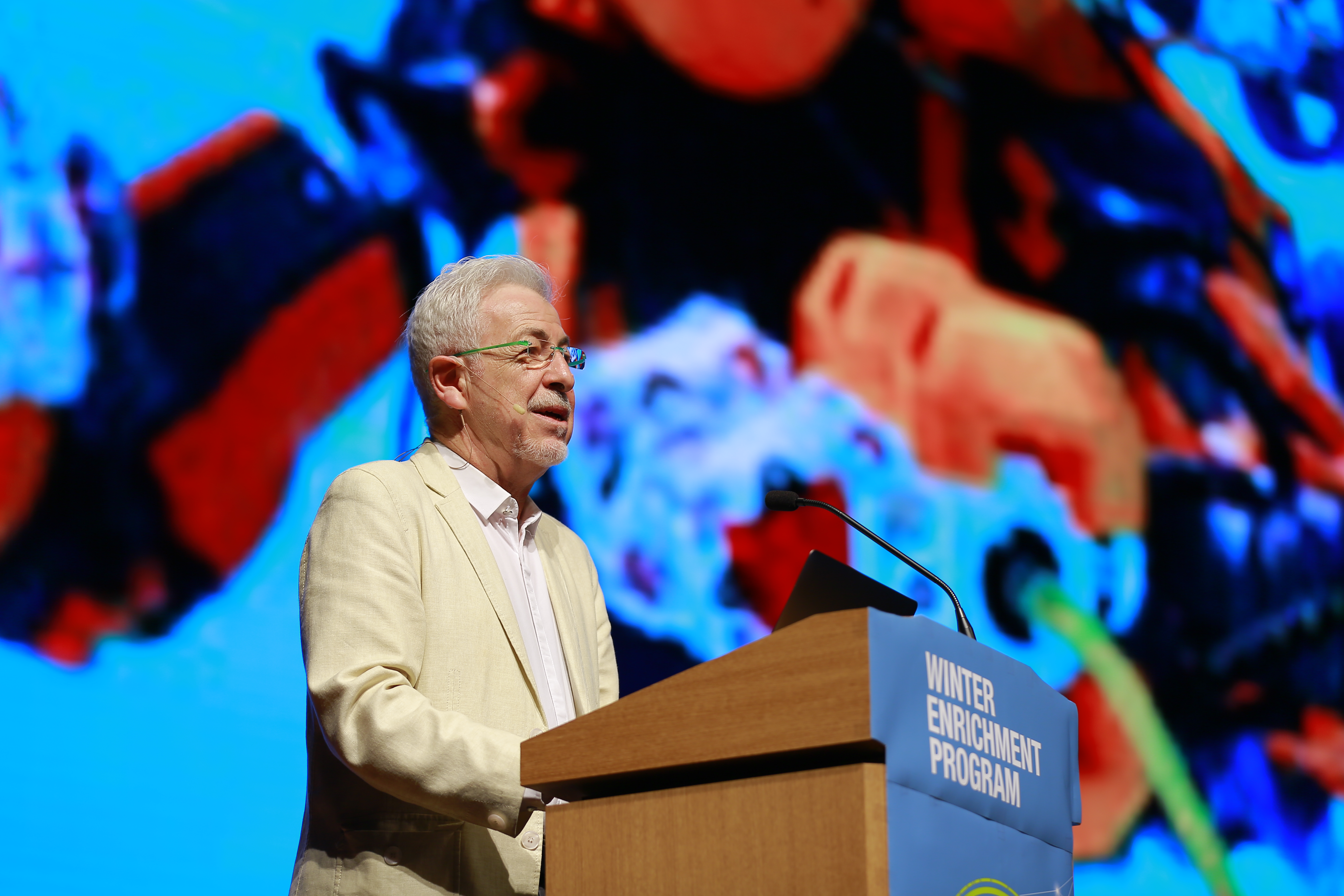Exploring deep-sea exploration

Oussama Khatib, professor of computer science and director of the Robotics Laboratory at Stanford University, delivers his WEP 2018 keynote address on human-robot collaboration on January 18. Photo by Asharaf Kannearil.
By David Murphy, KAUST News
The promise of oceanic discovery has intrigued and captivated scientists and explorers for centuries—be it to study underwater ecology and climate change or to uncover the natural resources and treasures buried beneath the waves.
On January 18, Oussama Khatib, professor of computer science and director of the Robotics Laboratory at Stanford University, expanded on this year's Human-Machine Future theme as he delved into his Winter Enrichment Program (WEP) keynote address entitled "The Age of Human-Robot Collaboration: Deep Sea Exploration." During his address, Khatib spoke about his work involving advanced robotics, which focuses on methodologies and technologies in human-centered robotics.
As the team leader of the OceanOne project, Khatib covered such topics as humanoid control architectures, human motion synthesis, interactive dynamic simulation, haptics and human-friendly robot design. He also discussed the growing demand for deep-sea exploration and the increasing role remotely operated vehicles (ROVs) play in exploration.
'Our collaboration could not have happened without KAUST'
To meet the challenge of operating dexterous ROV's at oceanic depths, in 2015, Khatib and his team at Stanford, in collaboration with KAUST professors Khaled Nabil Salama and Christian Voolstra from the University's Red Sea Research Center and with MEKA Robotics, developed the fusion of human ingenuity and artificial intelligence (AI) that is OceanOne. OceanOne is a bimanual underwater humanoid robot avatar with haptic feedback that allows human pilots to experience an unprecedented ability to explore the ocean depths in high fidelity.
Professor Christian R. Voolstra from the University's Red Sea Research Center partnered with Stanford University and Meka Robotics in California to develop Ocean One. Photo by Asharaf Kannearil.
"Our collaboration could not have happened without KAUST. This project started with the Red Sea and its corals. When we moved forward with the project, we realized there were so many applications for this type of robot," Khatib noted.
Thanks to its advanced technological prowess, OceanOne has the ability to distance humans physically from dangerous and unattainable workspaces while using their skills, intuition and experience during underwater research and recovery expeditions. At five feet long, OceanOne features a head with stereoscopic vision that relays instantaneous images back to the human pilot. The avatar also features two fully articulated arms and a tail section that houses batteries, computers and eight multi-directional thrusters.
"Creating a robot like this is not an easy feat. [Underwater] robots require capabilities that are beyond human limits. Our concept is that we connect the human and the robot in a unique way," he said.
"The robot is a sensor. It senses what it's touching and relays it back to the human onboard. Through the haptic interaction, the human feels what the robot touches underwater," Khatib added.
Oussama Khatib, professor of computer science and director of the Robotics Laboratory at Stanford University, delivers his WEP 2018 keynote address on human-robot collaboration on January 18. Photo by Asharaf Kannearil.
Khatib also described OceanOne's maiden voyage, which saw its deployment off the coast of southern France in the Bay of Toulon to explore King Louis XIV's 352-year-old wrecked flagship La Lune. Up until last year, the 17th century ship has remained relatively undisturbed, lying 32 km off the coast and in 90 meters of water for three and a half centuries. In collaboration with the French Ministry of Culture's Underwater Archaeology Research Department, OceanOne successfully navigated the wreck and recovered a number of precious artifacts.
"Before OceanOne our robots were incapable of examining shipwrecks. They simply weren't dexterous enough," he said. "On the La Lune dive, we touched a vase that had remained untouched by a human hand since 1664," Khatib added.
The harmonious marriage of Human-Machine
Throughout his keynote, Khatib focused on the fusion of AI and machine capabilities coupled with human ingenuity.
"In the last 15 years, robotics has been developing extremely fast—there are so many applications and industries that could benefit from robots. Something like mining could be revolutionized with a robotic presence instead of humans," Khatib emphasized. "Humans are our models to understand motion. Many of the algorithms we use in robots could be used for humans also—to understand how humans move and how we learn."
(From left to right:) Omar Knio, chair of WEP 2018; Professor Christian Voolstra; Professor Oussama Khatib; and Marie-Laurie Boulot, manager of Enrichment Programs, stand together after Khatib's WEP keynote lecture. Photo by Asharaf Kannearil.
"We need to program our robots in real-time—they need to be capable of sensing. We need a robot that can control its physical interactions—compliant motion is essential. In robotics, we connect the perception with the reaction. Humans are our models to understand motion—humans don't rely on precision we rely on instinct," he stated.
In his concluding slides, Khatib maintained that robotics brings us closer to the social sciences—to marine science, to archeology, etc. He also highlighted how his team of researchers and all those involved in the field of robotics are constantly aware that with any deployment of technology, they must consider existing ethical issues and the wider impact on society.
"We've been harnessing AI technology since the 1950s. In modern robotics, we bring the muscle, but we rely on the human brain. Current technology is bringing the human and the machine much closer than ever before," he said.
Related stories:
- Deep sea coral reefs more accessible with touch-sensitive underwater robotic platform
- Deep thinking brings underwater robot to life
- KAUST-born robotic avatar sets new era for undersea archaeology
- The day the Earth smiled
- Leaders—be the impact!
-
A career with purpose

